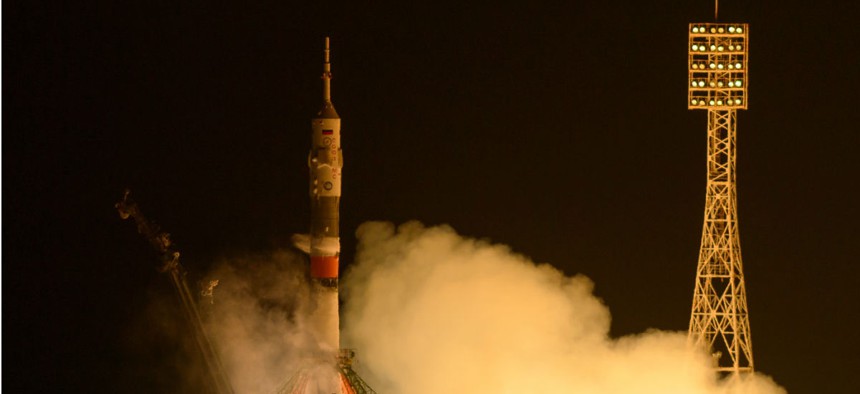
The Soyuz MS-03 spacecraft launches from the Baikonur Cosmodrome. NASA astronaut Peggy Whitson was among the crew members. Bill Ingalls/NASA
NASA Ranked Best Place to Work in Government For Fifth Consecutive Year
Homeland Security improves its score, but is still ranked last among large agencies.
The incoming Trump administration should focus on boosting the level of employee engagement among the federal workforce, according to the latest “Best Places to Work in the Federal Government” analysis from the Partnership for Public Service and Deloitte.
Employee engagement across government has risen slightly over the past two years, but there’s still a wide gap in that category between the public and private sectors, the nonprofit group found. The 2016 employee engagement score for federal employees governmentwide was 59.4 out of 100. Sirota, a survey research group, found an employee engagement score of 77.1 out of 100 for private-sector workers in 2016.
“Best in class private-sector organizations understand that improved employee engagement leads to better performance and improved outcomes” said Max Stier, Partnership president and CEO. “People are our government’s greatest asset, and the new administration should commit itself to strengthening the federal workforce and improving the workplace culture.”
The annual Best Places to Work in the Federal Government is based on data from the Office of Personnel Management’s annual Federal Employee Viewpoint Survey, which was released in September.
Agencies that were at the top and bottom of the rankings last year occupied those slots in 2015. For the fifth consecutive year, NASA was the No. 1 place to work among large federal agencies, with a job satisfaction and commitment score of 78.6 (out of 100) among employees. The Commerce Department, intelligence community, State, and Health and Human Services rounded out the top five. The rankings include 379 federal agencies and their subcomponents.
The Homeland Security Department, which has struggled with morale and management since its creation, ranked last among large agencies again. But the department had the second biggest increase among large agencies, boosting its score 2.7 points from 2015 to 45.8 out of 100. Secretary Jeh Johnson has made improving the department’s score among employees a priority; it was the first increase for the department since 2010.
The Veterans Affairs Department, plagued with management challenges since the 2014 scandal involving excessive wait times for patient appointments erupted, also ranked near the bottom of the large-agency list, but saw a 1.6 point improvement from 2015, for a 2016 score of 56.7.
The Securities and Exchange Commission was the most improved mid-size agency, gaining 7.5 points in 2016 for a score of 76.1, while the National Endowment for the Arts was most improved among small agencies, with a whopping 16.6 point increase in 2016 for a score of 85.9.
The Secret Service came in last among more than 300 agency subcomponents, with a dismal score of 32.8. The agency in recent years has struggled with low morale, a series of botched operations, and difficulty rooting out bad behavior among some employees.
The Federal Election Commission ranked last among small agencies and has the distinction of reporting the lowest score -- 28.4 out of 100 -- in the entire federal government on the Best Places to Work list.
The biggest factor affecting employee satisfaction and commitment overall in the Best Places to Work rankings related to effective leadership. Federal employees reported slightly more faith overall in their agency’s leadership in 2016 compared to 2015, but trust in top officials is still shaky (a score of 53 out of 100). The rankings also took into account employees’ views on pay, innovation and strategic management. Employees’ satisfaction with performance-based rewards and advancement fared the worst, with a score of 43.5.
---







